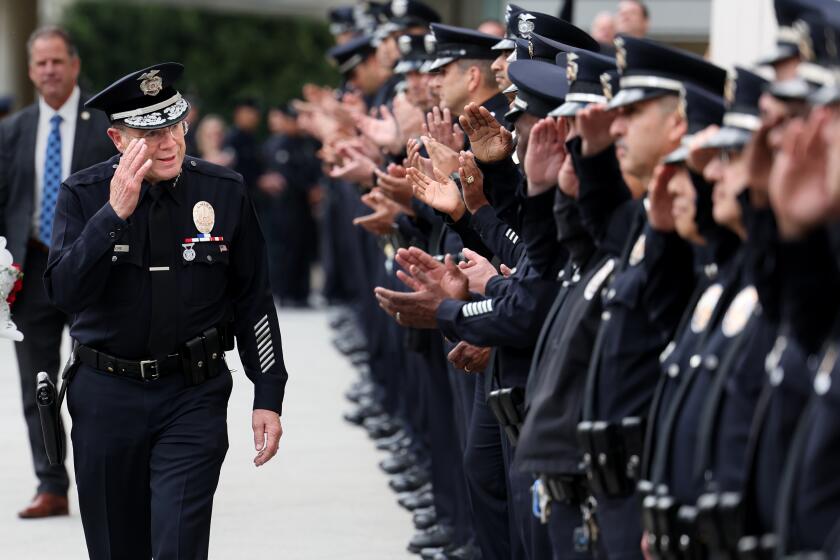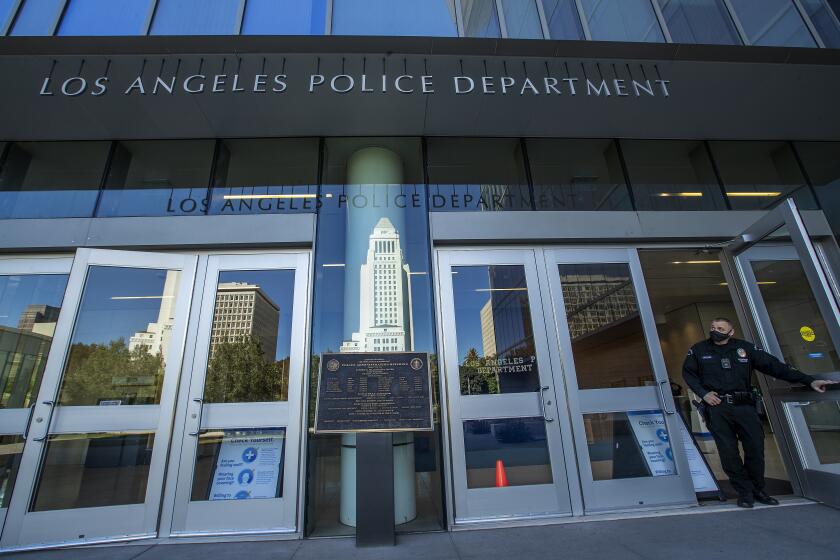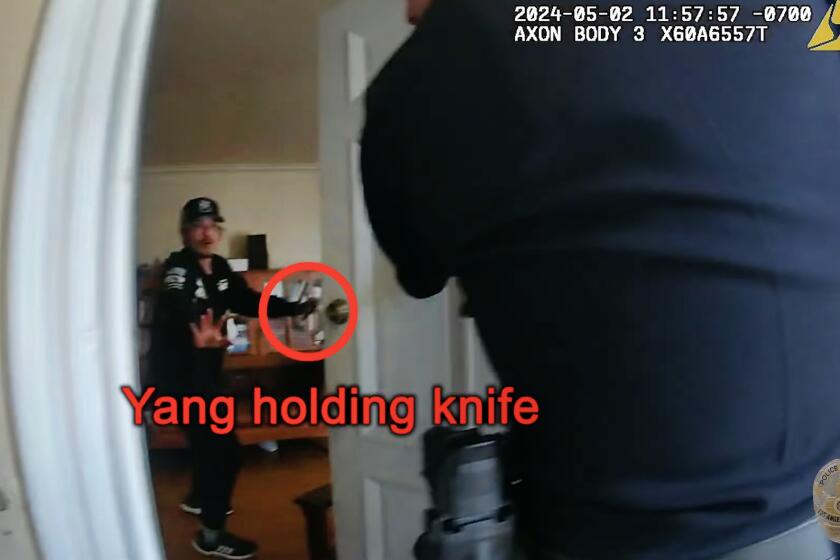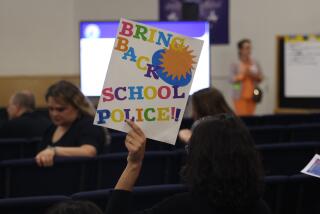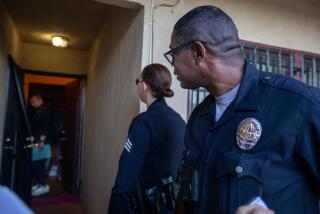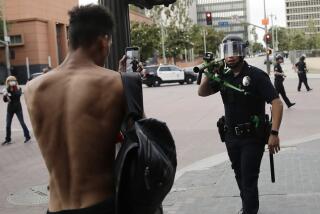‘Bringing a gun to a knife fight’: LAPD continues to shoot people holding ‘edged weapon’ during mental crisis, analysis shows

- Share via
Los Angeles police officials have been trying for years to curb officer shootings of people in crisis who are holding a knife, machete or other “edged weapon.”
Despite rolling out policies to prevent gunfire in such encounters, a Times analysis of LAPD data shows that there have been more shootings this year than in all of 2022. The department is on pace to eclipse last year’s total of 11.
In the first half of 2024, officers shot six people who were holding a sharp object while experiencing a behavioral or mental health crisis — a designation that includes those believed to be suicidal or under the influence of drugs or alcohol. Four were killed. There have been 17 police shootings this year, including cases involving edged weapons.
Since 2018, The Times’ analysis found, officers have opened fire in similar circumstances at least 56 times, killing 35 people and injuring 19 others.
The Los Angeles Police Department’s public-facing data do not track killings of people in crisis. The Times’ review is based on a variety of records, such as information disclosed in lawsuits, reflecting shootings that aren’t necessarily counted in the department’s annual use-of-crime reports.
Along with other agencies nationwide, the LAPD has adopted guidelines that prioritize de-escalation techniques and the use of “less lethal” alternatives to deadly force.
After recent high-profile cases in which officers killed mentally ill people, the department’s civilian oversight body has put renewed scrutiny on the issue.
In one confrontation in Koreatown in the spring, video showed an officer fatally shot a man experiencing a bipolar episode in his parents’ apartment as he walked slowly toward police with a knife.
A Korean American family caring for a mentally ill son asked for help. An LAPD officer shot and killed him.
The May 2 killing of Yong Yang, 40, was followed by two more fatal edged-weapon shootings, prompting the Los Angeles Police Commission to ask for a report on department training and policies.
“I want to make sure that all other efforts are exhausted before lethal force is used,” the panel’s vice president, Rasha Gerges Shields, said at a June commission meeting.
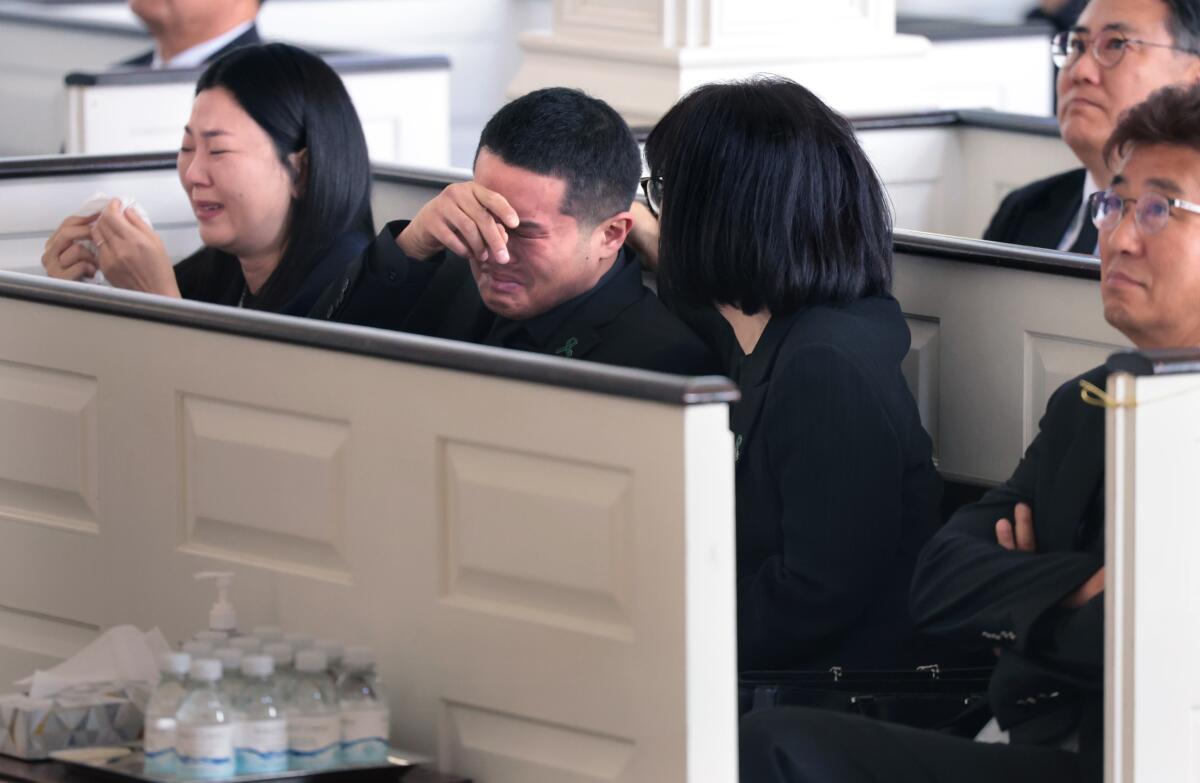
LAPD officers are taught to use space and time to prevent confrontations from getting to the point where they are forced to fire their weapons, according to Jonathan Wender of the police training firm Polis Solutions.
In situations where a suspect is indoors and doesn’t pose a threat, Wender said, some agencies are training officers to simply “contain” instead of rushing in to make an arrest.
Officers also are encouraged to use Tasers, beanbag shotguns or projectile launchers to try to subdue people in crisis, Wender said. But these “less lethal” weapons can prove ineffective or have unintended consequences, he said, such as provoking a subject to charge at officers.
The LAPD has had only two outsiders serve as chief in its modern history, but there is a growing push to bring in a third.
“There’s going to be side effects,” he said.
LAPD officials previously acknowledged that confusion over a recent state law resulted in officers occasionally waiting too long into an encounter before deploying a 40-millimeter launcher. The department has since updated its policies to allow use against anyone who poses an immediate public safety threat.
The Times reviewed LAPD records from more than 200 cases in which officers fired at people over a five-plus-year period, along with hours of associated body camera video, search warrant affidavits and civil lawsuits filed by the families of those killed or injured.
Behavioral crises involving edged weapons accounted for about 27% of police shootings between 2018 and the present, with the LAPD’s Central and Valley bureaus recording the most instances. The officers who fired their weapons had an average of about nine years of department experience.
Shootings of people wielding sharp objects were more likely to end with someone being killed than were confrontations involving suspects armed with guns — which ended in a death in less than a third of the cases — The Times’ review found. The edged-weapon cases resulted in fatalities more than 60% of the time, including one innocent bystander.
Of the 56 edged-weapon cases, police officials deemed the shootings “out of policy” — meaning they should not have occurred under department standards — eight times.
In two cases, officers accidentally shot the victims of knife assaults while trying to save their lives.
In 2021, an 11-year-old boy who was being stabbed by his mother was struck by “bullet fragments” when police opened fire to stop the attack. The boy’s mother was wounded.
In the other case, police in 2018 fired at a man who was holding a knife to his ex-girlfriend’s throat at a Van Nuys homeless outreach center, killing both of them.
Before both shootings, officials said that officers had tried to request help from a Systemwide Mental Assessment Response Team, or SMART, which pairs cops with county mental health clinicians. But all the SMART units citywide had been tied up with other calls, prompting former police Chief Michel Moore to order a review of dispatching procedures in mental health-related cases.
LAPD officials say they long ago stopped teaching the “21-foot rule,” which suggests that anyone with an edged weapon within that distance represents an imminent threat.
But William Briggs, a former police commissioner, said that mindset has endured, with many officers being told from their earliest days in the field that people with knives can always harm them, even when far away. As a result, he said, some officers give “less lethal” options little or no time to work before opting to shoot.
“You’re bringing a gun to a knife fight,” said Briggs, who retired from his post last month, adding that he has long pushed for more hand-to-hand combat training to teach officers how to disarm people without killing them, including those threatening “suicide by cop.”
“If we had that kind of training, that would be one thing,” Briggs said. “But the critics within the department and within the union, they say, ‘We don’t want our officers hurt.’”
The LAPD’s much-maligned disciplinary system is on the verge of a major transformation. Members of the Police Commission don’t want to be left out.
The law allows LAPD officers to use deadly force to protect themselves or others from the immediate threat of death or serious bodily injury. They also are permitted to shoot at people who are armed but not actively attacking, but only as long as they can articulate how that person had the potential to seriously harm or kill someone.
Police dispatchers are required to send a supervisor when they receive a call about an edged weapon, and department policy tells officers to give verbal warnings before firing and only use force that is “objectively reasonable” and proportional to the threat they face. Officers are expected to discuss among themselves how to best approach a suspect, designating specific roles to limit the number of guns drawn.
Department officials say that overall police shootings are far below the levels seen in the 1990s and the large majority of mental health-related calls end without any force being used. In 2023, about 93% of patrol officers who responded to emergency calls had completed a 40-hour training course on mental health intervention, officials said; the class is mandatory for all recruits.

Yet edged-weapon shootings remain regular occurrences, raising questions about whether the training has taken hold.
The Los Angeles County Sheriff’s Department also has a long history of shootings involving mentally ill people wielding knives or less dangerous objects.
Two years ago, deputies shot a Lancaster woman who was armed with a knife and threatening to kill herself inside her home. When the woman, who was seated at the kitchen table, began advancing toward the deputies and refused to drop her knife, the deputies opened fire, the department said.
In that case, the deputies did not wait for the department’s Mental Evaluation Team before entering the home — a common occurrence that has been questioned by oversight officials. L.A. County Inspector General Max Huntsman said he considers knife shootings a “very serious issue” on which “we could make real changes such as through funding real response units like the MET [Mental Evaluation Team].”
The Sheriff’s Department said that it has 34 MET units that operate around-the-clock throughout the county, with an additional 10 dedicated to the transit system. “Patrol units face situations in which they are not aware a person suffers from a mental illness or has a developmental disability,” the agency said in a statement.
The department moved faster than normal to release the footage of the May 2 fatal shooting of Yong Yang in his parents’ apartment.
LAPD shootings overall have dramatically declined in recent decades. But several recent cases have again cast a spotlight on police interactions with people who are mentally ill — and drawn concern from department leaders.
In February, police fatally shot 36-year-old Jason Maccani while he was going through what his relatives described as a bipolar episode. After officers hit Maccani with a 40-millimeter projectile, he began moving toward them. One officer then opened fire at point blank range, apparently mistaking a plastic fork he was holding for a weapon.
In about two-thirds of instances where officers fired their handguns and less-lethal weapons at an armed person — which sometimes happened simultaneously — they were reprimanded or ordered to undergo retraining for lapses in judgment. But even when officials concluded that the actions leading up to the shooting violated department policy, nearly 80% of the time the shooting itself was found to be justified.
Such was the case with the Jan. 3, 2023, police shooting of Oscar Sanchez, when Moore faulted a supervisor for not consulting the mental health unit and for ordering officers to pursue Sanchez after he kicked down the front door of what turned out to be his own apartment. Moore recommended to the commission that the shooting be found “in policy” because the officers said they feared the 35-year-old would harm someone else after a Taser and 40-millimeter launcher proved ineffective.
City leaders, and even some senior LAPD officials, have acknowledged that not all mental health emergencies require the presence of armed police. In the wake of George Floyd’s murder by Minneapolis police in 2020, L.A. was among the major U.S. cities that pledged to develop and invest in new emergency responses that use trained specialists to render aid to homeless people and those facing mental health and substance abuse issues.
Several crisis response programs have sprouted across the city on a trial basis. But activists have raised concerns about the continued underfunding of such programs and other, community-led efforts that are not aligned with law enforcement.
Calls involving weapons or threats of violence are still almost always funneled to police. And some officials argue that the alternative units are often unavailable or take too long to respond to emergencies — which officials have blamed on under-staffing at the county.
Briggs, the former police commissioner, recalled a police ride-along in which he waited an hour and 50 minutes for a SMART team to arrive. He supports such alternatives, but does not fully endorse diverting all mental health-related calls to unarmed clinicians, as a growing number of activists and city leaders have pushed for.
“You never know what could happen in that situation; that person could be killed,” he said.
Times staff writer Keri Blakinger contributed to this report.
More to Read
Sign up for Essential California
The most important California stories and recommendations in your inbox every morning.
You may occasionally receive promotional content from the Los Angeles Times.

